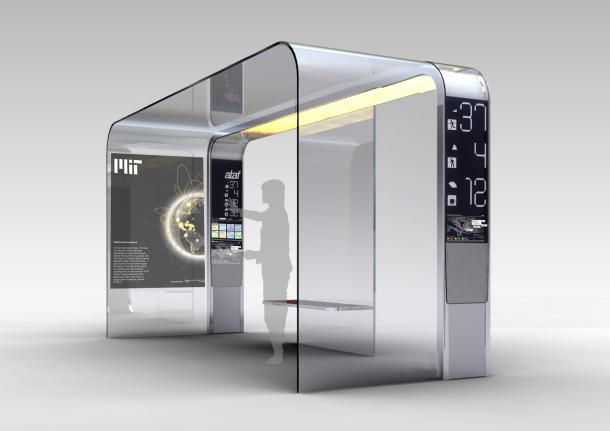Unless you are a secret admirer whose only chance to see your crush is on the bus to school or office, bus stop is not a place you would want to pay a visit. But with the ever-rising oil price, the ever-worsening traffic, more and more people are forced to choose the bus as their primary transportation. Bus stops become indispensable in the daily schedule of many city commuters. As life is changing, we have to, and the right bus stops will improve as well. Walyou introduces 19 most innovative bus stop concepts that include awesome designs, and besides the actual 17 Bus Stops we seen earlier, they make for a great dream. Let’s pray that they would come to your city someday.
For other cool designs, check out the 21 Geeky Furniture Designs, the 16 Lego Torture Devices or the 15 Weird Tank Designs.
Real Experience Bus Stop
This bus stop concept was proposed by a group of researchers at Massachusetts Institute of Technology to be installed next year in Florence, Italy. The EyeStop, as it is called, features touch-screens as well as LEDs that provide Web access, tools for planning a best route, and getting directions. You can choose to have your local EyeStop to sync with your phone to get latest updates about your frequent buses.
Source 1
Bus Stop Intelligent Series Flex 
Built with sustainable materials, bus stop shelter Intelligent Series Flex blends in harmoniously with the modern urban landscape. It also features a bluespot terminal equipped with advanced technologies including telephone, WiFi, solar panel roof, dynamic display for schedule updates and announcements, advertising display case, bench, and waste bin.
Source 1
Urban Botanical Garden
“Urban Botanical Garden” bus stop provides a variety of services grouped around the garden metaphor. Pedestrians leave multimedia messages, presented as a leaf in the garden, for each other. They can either be viewed or downloaded via mobile phones. Users waiting inside the bus stop engage via a touch screen interface while pedestrians waiting outside interact with a 6ft. custom LED display.
Source 1
TU Colibri Bus Stop
Designed by Beatriz Cockburn to improve local public transport in Peru, the “TU colibri” displays route and time statistics on the touch sensitive information block. The bus stop uses LEDs to indicate the changed routes. It also integrates solar panels on its roof to run the bus stop on renewable energy.
Source 1
Abrigo do Onibus
The conceptual bus stop, called “Abrigo do onibus,” is made from recycled wood and plastic composite lumber under a durable plexiglass roof which can keep the interior cool. It is also equipped with a touch screen that display information about the number of buses plying on a desired route and their timing as well.
Source 1
Internet-Enabled Adaptable Bus Stop
This transparent bus stop will be capable of sending a wireless Internet signal to a neighboring bus stop, thus creating a wireless mesh network across the city. Each bus plying the route will be equipped with a GPS transmitter to send real-time location information to each stop. A touch-sensitive map will also be installed to allow passengers to plan the ideal routes by interacting with the community via the Web.
Source 1
GPS-Enabled Bus Stop
No less innovative than bus stops of the West, every bus stop in Chennai, India will soon have a Global Positioning System, a vending machine, a public telephone, a cell-phone charging outlet, ceiling fans, and security guards.
Source 1
Hi-tech San Francisco Bus Stop
To be implemented in the heart of Silicon Valley, these bus stops will be armed with the most advanced technologies: WiFi and LEDs using solar energy. These shelters are also built entirely out of recycled materials. San Francisco will have 1000 of these hi-tech solar-powered shelters by 2013.
Source 1
ROUNDbus Stop
Dubbed as ROUNDbus Stop, the brilliant concept was designed by Viera Gorelova. It is intended to increase the eco-friendliness of the already car free Bratislava, Slovakia. The bus stop hosts a solar powered roof to light up the shelter in the dark. It also has a touch screen that renders info about the locality for the tourists.
Source 1
Ecoshel Sustainable Bus Stop
To attract more people to use public transportation, British designer Tiffany Roddis has designed an environmentally friendly bus stop called the “Ecoshel.” The shelter integrates solar panels, electric generators, and pressure pads to reproduce its own electricity and heat. The Ecoshel also features an advanced route finder and GPS to guide passengers to reach their destinations on time.
Source 1
Solar Bus Stop
Bus stops’ large protective panels provide ideal space for application of solar cells. And because bus stops generally don’t consume much of the energy, they can work as an electricity plan as they are connected to each other as well as to the electric company.
Source 1
Bike Storage Bus Stop
As part of London Garden concept for a car-free zone of 4 students from the Royal College of Art, this futuristic bus stop triples as a bike storage and an electricity house. Bikes can be folded and stored on the tree like structures on top of the shelter. Energy generated by cycle racks from rainwater, sun, and wind can be stored in the bus stop and use for electric buses.
Source 1
“Walking” Energy Bus Stop
Instead of relying on mother nature for renewable energy, industrial designer Laurence Kemball-Cook tried to convert energy of walking people for a green charge. When people walk over these power generating slabs known as “Pavegen,” the energy generated is converted into a small amount of electricity which will be used by the bus stop to glow at night.
Source 1
Landmark Bus Stop
To make up for its lack of hi-tech features, Landmark bus stop presents a stunning design with a lighting system in one side that shines in changing colors, especially at night. An advertising showcase for double-sided posters is integrated into the other side in the City Light format.
Source 1
Bird-Bus Stop
This green shelter will not only serve as a bus stop but also a mini garden and an educational center. Each bus stop will have in the roof top a selection of local plants that will provide home and food for various bird species to invite them back to the city. There will also be information about birds, native plants, and the environment. This disposable shelter can be assembled from few components without glue.
Source 1
Drop Spot Bus Stop
The Drop Spot was designed by Jonas Elslander and Jeroen Robberechts as a draft assignment under “Space Saving & Space Creating Collapsibles.” The concept is an inflatable, collapsible, easy-to-install shelter that offers an instant and cost-effective alternative to bus stops and rain shelters. The weather resistant shelter is made of eco-friendly fabric and leaves no harmful waste to the environment.
Source 1
Slough Bus Stop
The new enormous Slough bus stop, designed by Bblur architecture, is a true piece of contemporary art. Stretching over 450 sq m, the shelter provides 10 bus bays together with facilities including waiting rooms, a coffee shop, newsagents, toilet facilities, and cycle stands. It also features a unique 140 meter feature length canopy.
Source 1
Ergonomic Bus Stop
This whimsy concept was developed by designer Martin Necas to demonstrate the ergonomic aspect of a bus stop. This shelter is roomy enough to sit 4-6 patiently waiting passengers, with some space for a stroller or a wheel chair too. The benches are crafted from hard wood and galvanized steel. The glass on one side is to make the concrete construction more elegant.
Source 1
BusStopSymbiosis
The worm look a like piece crawling outside doesn’t only make comfortable seats for commuters, but also brings us closer to nature. BusStopSymbiosis, as it is called, was created by LIKEarchitects’ as part of an ongoing challenge in Porto, Portugal, to improve the daily life of local residents.
Source 1





























